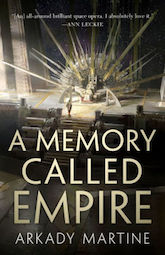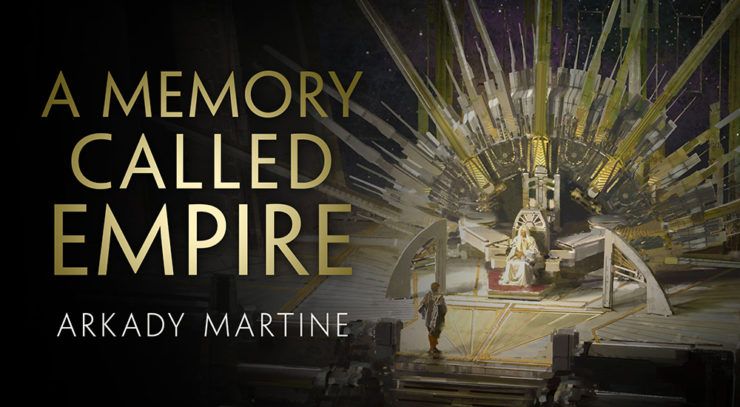In this stunning debut, Mahit Dzmare is the latest in a long line of free peoples who have had to live under the influence of the one of the largest imperial powers in the known galaxy: the Teixcalaanli Empire. The vast Empire is a source of culture, poetry, fashion, literature, oration, ethics, and more, whose influences spread across their many systems and beyond, like arrows of sunlight streaking into the dark of space. And while very few are able to stand up to and apart from the Empire, Mahit’s people on Lsel Station remain independent, though they exist next to and within the grasp of the Empire, aided by an ambassador on the surface of the Teixcalaanli capital—a planet simply called “The City,” heart and jewel of the Empire.
When a sudden call for a new ambassador comes to Lsel Station, Mahit is chosen and hurriedly given her imago, the tiny piece of technology that gives her access to an old memory-self of Yskander, the former ambassador. The imago integrates Yskander into her neurology, so that he’ll always be in her mind in order to help and advise her. The only problem: the imago hasn’t been updated in years, and both Mahit and Yskander are in the dark as to the current situation within the City, and what happened to current-day Yskander. Only upon landing does Mahit learn what’s happened: Yskander is dead…and with that revelation, her imago goes silent.
As A Memory Called Empire begins, Mahit, who for her entire life has feared, adored, disdained, and emulated the Teixcalaanli, must survive in their world as an outsider in every way. More than that, she must reckon with a malfunctioning imago, tenuous alliances, and strange and charismatic enemies. Beyond juggling dozens of complex moving pieces in her new assignment, she must work to understand how they all fit together if she’s ever going to succeed in figuring out what exactly Yskander was up to, why he died, and what she’s going to do about it now that she’s at the center of the intrigue.
Martine hits the ground running, and the relentless pace doesn’t let up for the entire book. Aspects of the story that could come across as stiff, detailed worldbuilding or decadent indulgence in the multitude of characters running around in other hands are instead deftly incorporated into the forward motion of the plot. Martine has perfectly calibrated each chapter to do as much as possible to serve character, emotion, plot, and worldbuilding, all in perfect balance with each other. Martine’s writing is a brilliant, measured exercise in raising stakes, propelling emotionally rich and complex characters forward, and delivering information that always feels organic to the situation. Not only that, but her worldbuilding is some of the most elegant and rich I’ve come across in recent science fiction. The world of the Teixcalaanli Empire and Lsel Station, and the complex web of relationships the two share—and beyond that, the intricate and delicate relationship Mahit maintains with both cultures—unfurl throughout the novel like a flower in bloom. As each petal opens up, more is revealed, leading to the next revelation…each piece of worldbuilding falling in a natural way that speaks to Martine’s talent, skill, and control over her story and the world she’s created.
Buy the Book


A Memory Called Empire
And what a rich story! What an intricate world! It is easy to see why Mahit and many other characters are seduced so irrevocably by the ways of the Teixcalaanli; everything about the Empire, and every way in which they’ve created their culture serves their image as the only bastion of civilization among the stars. Names are poems, made up of numbers, combined with flora, function, and other such metrics—thus you’ll meet wonderful characters such as Three Seagrass, Twelve Azalea, Six Direction, Thirty Larkspur, Nineteen Adze, and so on. The City itself is a fully functional organism, all run by systems of artificial intelligence which help to guide and lead Teixcalaan’s citizens through their day-to-day lives. And no imperial function would be complete without some sort of poetry contest, where a subversive verse is enough to cause scandal. Martine’s showcasing of the Empire, when juxtaposed with the more realistic, gritty, forms of artwork of Lsel Station, illuminates a fascinating struggle familiar not just to Mahit, but to anyone who has ever been enamored by a culture they love while being equally terrified and angry at how it swallows and consumes everything in its path.
Ultimately, the temptations of the City and the Teixcalaanli Empire, and the struggle to truly be seen as “civilized” in the eyes of those who defined the word, rather than a “barbarian,” provide the story’s central conflict, as Mahit fights against warring impulses. Does she give in to the joy she feels at being accepted by a people and a culture that look down on her, or instead defend the fierce pride and love she has for her home, protecting that identity and those parts of herself from the mighty, overwhelming influence of the Empire? Martine doesn’t turn away from the brutal forms this type of emotional colonization can take, nor from the effects it can have on the souls being forced to grapple with the effects of that colonization. By the end of the book, I myself could feel the enormous pull of the Empire, even as I grew more and more disgusted by its very existence and what it might demand of me.
But none of the above would leave such a profound impression on the reader were we not fully invested in the characters expressing these ideas and caught in the middle of these temptations. Mahit is a fish out of water for much of the novel, but she’s intelligent, quick, and savvy enough to both learn on her feet and try her hand at political improvisation when necessary. In a world in which everyone constantly underestimates her, dismissing her as a barbarian, Mahit is quick to learn how to play a game she’s not supposed to know how to win. Watching her grow with every step, as she pushes herself to take risks and learns to navigate the labyrinth of Teixcalaanli bureaucracy, made me fall more and more in love with this character, and find myself in awe of her.
By Mahit’s side is her aide, Three Seagrass, a higher-up in the world of information within the City and an excellent foil for our protagonist. Dry, biting, sarcastic, but brilliant to a scary degree and willing to do whatever it takes to keep her charge safe, Three Seagrass shines in her every interaction, as she and Mahit not only work together, but work to understand each other, as well. And of course, the upper echelons of Teixcalaanli culture offer a host of complex figures that Mahit must attempt to figure out, since they’re involved in the conspiracy of Yskander’s death: there’s ruthless, efficient, and soft Nineteen Adze, wise and terrifying Six Direction, aloof but steely Thirty Larkspur, and so many more notable characters along the way.
Arkady Martine has created a stunning accomplishment with her debut novel; A Memory Called Empire is a success by every metric possible. It has compelling, complex characters that made me root for them with every turn of the page. It features a world that is as rich and decadent as German chocolate cake, and one that I can come back to again and again for seconds. It raises complex, thorny issues about colonization, empire, culture, society, identity, personhood, economics, and so much more—issues that are interrogated and investigated with a clear eye not given over to cynicism. At the end of the day, this novel asks questions of the reader that left me deep in thought for months after I’d finished the book. In fact, I’m still thinking about them. And I’m most likely going to start my second read as soon as I’ve filed this review. The Teixcalaanli would look down on me telling you what to do in such a direct manner, but I don’t mind being a barbarian in their eyes, so here’s my advice: go read this book. You’re going to love it.
A Memory Called Empire is available from Tor.com Publishing.
Read an excerpt from the novel, starting here with the prologue.
Martin Cahill is a contributor to Tor.com, as well as Book Riot and Strange Horizons. He has fiction forthcoming at Beneath Ceaseless Skies and Fireside Fiction. You can follow his musings on Twitter @McflyCahill90.










